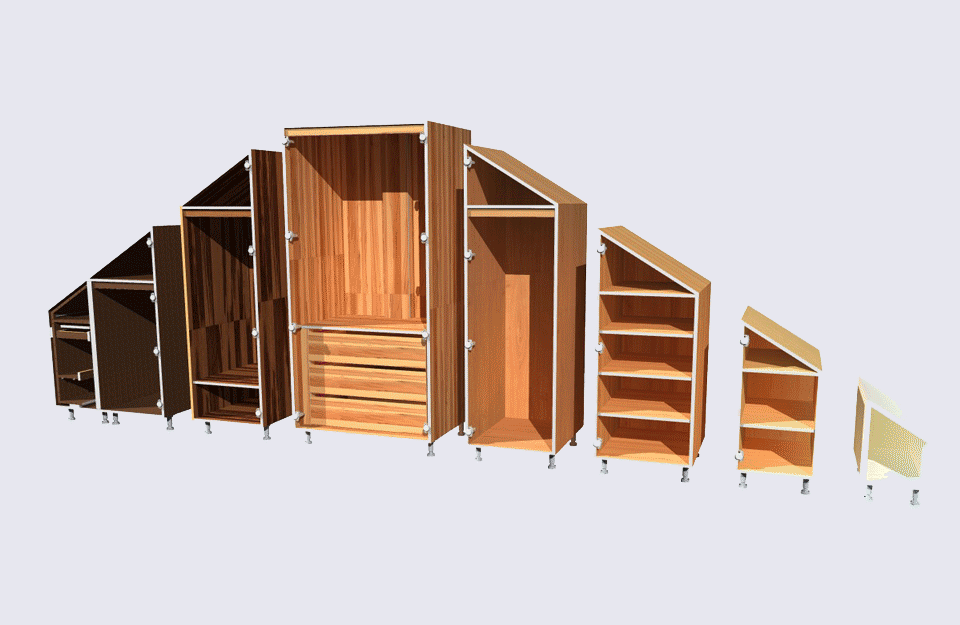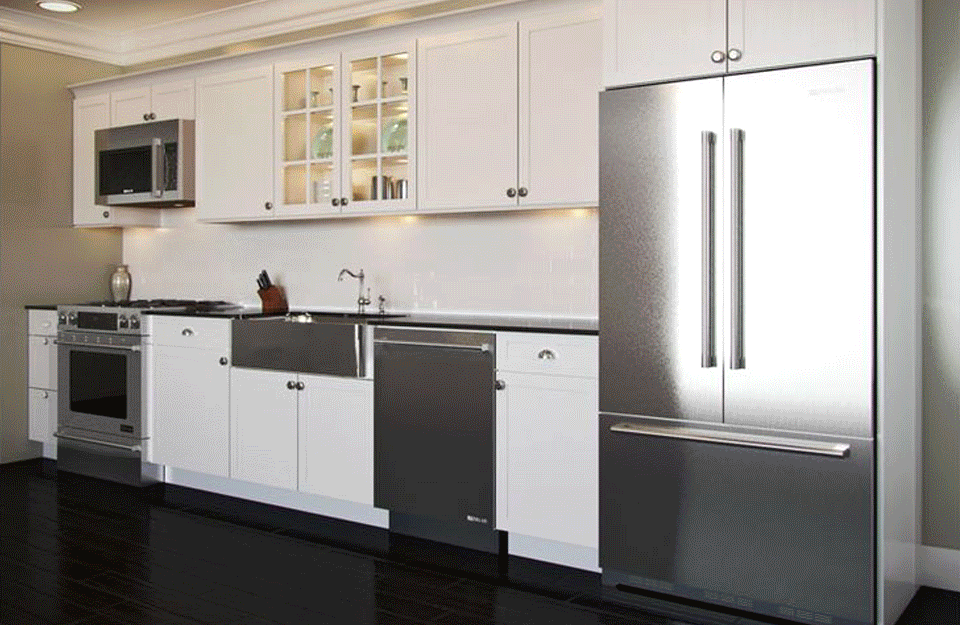News
What’s the Difference Between MDF & Particle Board?
Author Chigwell Building & Joinery
Date 15/09/2017
Understanding these popular wood products and their practical uses
To the unwitting public, many do not realise the fundamental differences between particle board and medium density fibreboard, with many believing they are one and the same thing. This is not the case.
Particleboard is a relatively cheap product which is composed of wasted wood chipping which are compressed and bound using a compound of resins and sawdust along with a lot of heat and pressure. MDF, a more denser product, tends to be more expensive is composed of tiny wooden fibres as opposed to dust but it again, combined using resins and pressurised heat.
In most cases, furniture that is made from MDF is considered to be superior in quality and strength compared to particle board.
What is Particleboard?
Particleboard tends to be used on jobs that do not require a high end durable material and can be commonly found in cheaper furniture products, as well as used in building projects such as flooring substrates and underlays, panelling on fibreglass roofs and temporary partitioning. It’s considered to be a throw away material that has good temporary uses on building projects but seldom is applied for too many permanent structures.
It’s a fairly easy material to work with in terms of cutting and milling but due to it’s structure, tends to tear or chip frequently as pieces of wood chipping start to break away under pressure. Rarely does particleboard get used as a visually exposed face as it is not a great looking product and will often be veneered with a thin laminate to make it appear much more higher end.
It is best used flat as when put under any pressure such as bending or moulding, it breaks, snaps and tears easily.
What is Medium Density Fibreboard?
MDF as it is more commonly known, can be found is many mass produced furniture pieces such as cabinets, shelving and even kitchen units and doors. It’s a strong material that is far easier to mill than particleboard because it is les prone to chipping and tearing. It can be shaped and moulded to a degree and tends to work well for projects requiring routing complicated and elaborate shapes.
Much like particleboard, MDF does tend to be veneered with a laminate on furniture pieces as the material isn’t aesthetically pleasing to look at, so veneers give it a high end finish. it also tends to take to being painted far better than particleboard as well as being far stronger under pressure. It is however not a great material to be used in damp conditions and like particleboard, will deteriorate fast is exposed to moisture of water for too long.
Why the quality of your kitchen carcasses is important
Author Chigwell Building & Joinery
Date 09/08/2017
Determining which kitchen units are made to last
When shopping for a kitchen, seldom do buyers consider the quality and construction of the actual kitchen carcass they come with. In most cases the doors, the colour and the finish is what either makes or breaks a sale yet the carcass is the item that will need to take the brunt of the pressure when it comes to daily use and abuse.
Of course, the quality and manufacturing process of the doors is important but in overall structural terms, they have very little influence. The materials, construction style and strength of the kitchen carcasses is what really matters to the quality of the final product and its longevity, not to mention taking the weight of the worktop and built-in appliances. They need to last!
A strong back makes for a strong unit
In most cases, kitchen carcasses made in the UK are formed of 18mm chipboard with PVC coating and edge banding, where the strength of the units is focuses on the back section. Here is where you can reveal the good from the bad as the strength and quality of the back panels can vary greatly. On certain cheaper units, they are backed with a thin 3mm or 6mm hardboard which is not considered to be a rigid material at all. Flimsy at best.
Over time, if a lot of weight and pressure is applied to carcasses with thin back panels, they will start to bow and sag or worse, the back panels will pop out of place completely making the carcasses useless. The issue is, you may not even see this occurring as the back panels are frequently out of sight so by the time the inevitable break down has occurred, it’s probably too late.
If possible, shop for kitchen carcasses that have rigid back panels of at least 18mm in thickness or sectional panels in 18mm that will take the brunt of the weight and be able to last many years. You could save yourself a lot of worry and longer term, won’t have to concern yourself with the messy job of replacing individual carcasses that may not have lasted as well as the others.
Thick edging means longer protection
Another sure fire way to determine the quality of a good kitchen carcass from a bad one is the edge banding thickness.
Many mass produced carcasses from well-known DIY stores and even big brand kitchen retailers are commonly sold with a thin iron-on type melamine edging which is very prone to peeling, cracking and snapping. The edging isn’t just there to make the units look good. They have a very important role to play in protecting the carcass edges from damage from persistent use and abuse. Doors and drawers are constantly opened and closed so a cheap edge band will start to crack under the strains of slamming and constant closing of doors.
A good quality unit should have edge banding of at least 0.4mm to 2mm in thickness and be made of PVC or ABS, not melamine.
So if you are considering a brand new kitchen or even a simple kitchen facelift by replacing the carcasses, do not necessarily shop around for the most economical option. Chances are, it will be cheaply made and will start to deteriorate quickly after installation. As the saying goes, you only get what you pay for so if you’re investing in a new kitchen, a few extra pennies on quality is an investment well made.
The 7 Most Common Kitchen Design Layouts
Author Chigwell Building & Joinery
Date 10/07/2017
Deciding on a Kitchen Plan & Making It Work
When installing a brand new kitchen, the layout is by far the most important design aspect before you even choose a single cabinet style, colour or finish. How that overall shape and plan lies will determine a whole range of factors such as usability, convenience, space and aesthetic appeal.
Nowadays, there’s all sorts of trends or unique designs features that have grown in popularity however, in many circumstances, these choices are not always practical. The shape and scale of your kitchen will ultimately determine which type of design you can realistically aim towards and how to successfully achieve it.
Let’s take a look at the most common kitchen layouts and then you can decide which will work best in your kitchen based on the dimensions and shape of your existing space.
Single-Walled Kitchen
Typically found in smaller homes with narrows rooms, the single walled kitchen is actually growing in popularity in larger homes too as it keeps all the appliances, workspaces and stored items within easy reach. No matter the size of the room, this layout instantly creates a very open concept and creates useable space for other essentials such as dining tables or even a portable island or preparation console table.
The single walled kitchen does have its pitfalls however. Naturally, every kitchen needs to find a home for the oven, cooktop, sink and refrigerator. With all four of these must-haves sat along one wall, it does become quickly apparent that countertop space will be limited. So if a single walled kitchen is your only option, you may have to opt for an integrated range cooker instead and even a smaller refrigerator to allow for more storage and worktop space.
Galley Kitchen
Much like the single-walled kitchen, the galley also lends itself to the narrower, smaller spaced kitchen where walkways are tight and the dimensions are squeezed.
What the gallery has over the single wall of course is the opportunity to create separation of work areas such as food preparation and cleaning and far more countertop space. The downside is galleys can feel quite claustrophobic if the walkways between to the two sides are tight so having more than one or two people preparing and cooking meals in a galley is never a comfortable place to be.
If you’re quite cheffy though, galley kitchens are great as it means everything you need is within arms reach so preparing and cooking food is always a pleasure. It is most certainly a layout designed to please one primary cook in the house but avoid if you like to work in teams.
U-Shaped Kitchen
Like the single-walled or galley, U-shaped kitchen layouts are ideally suited to a single cook who likes to have everything at arms length.
What is great about a U-shaped kitchen is there’s no walkway to encourage people to pass through the area so the chef in the house will not have passers by interfering in the workspace and they can just get on and do their thing. The downside is the obvious lack of space for anything else so you can forget about including any tables, chairs or islands in the kitchen.
U-shaped kitchens are also poorly designed for those who like to entertain. In most cases, the person cooking will have their back to the room so it can feel quite enclosed and unwelcoming to guests. If the room is also small, a U-shape can quickly start to dominate the space and make the room feel incredibly tight.
G-Shaped Kitchen
The G-Shaped kitchen is essentially an upgrade of the U-shape with an added peninsula island to add practicality and extra workspace.
If room allows, this added little bonus can really make the difference to a U-shaped kitchen as it creates an island that can be somewhere to entertain, eat meals and prepare food. What you must avoid of course is making it into a nuisance object that gets in the way of accessing the kitchen easily so there’s a balance to strike - too large and it will block the entrance to the kitchen. Too small and it won’t be big or practical enough to use for eating or cooking.
L-Shaped Kitchen
The classic corner kitchen is mostly found in apartments or kitchens that lack a room long enough to house a single walled kitchen.
With more and more people living in apartments, the corner L-shaped kitchen is becoming far more commonplace as it is the sole kitchen design layout that encroaches on the least amount of space. With all the units tucked into the corners, it feels openly inviting but much like the U-shaped kitchen, entertaining is not ideal when the cook has their back to the guests.
What it does allow however is for the addition of a small table and chair for dining or if budgets and space allows, an island which will take it to a whole new level.
L-Shape with Island Kitchen
Take a look online for photos of kitchens with islands and the likelihood is you’ll find plenty of L-shaped kitchens with islands, and it’s no great surprise.
This simple design configuration fits comfortably into most room dimensions and ticks all the right boxes. Firstly, it creates distinct zones to the kitchen meaning one wall is for cooking, one for cleaning and the island is for serving up food and entertaining. For the chef in the house, there’s easy reach to get all the necessary items from cupboards and larders, so cooking is a pleasure. And in terms of space, it doesn’t take up huge amounts yet makes the entire kitchen area feel roomy and sophisticated.
As a bonus, the island gives the homeowner the choice of installing the cooktop of the sink here if desired; otherwise they can just keep the worktop and use it for preparing meals, eating and hanging out with friends.
Wrap-Around with Island
If room allows, the wrap-around kitchen with island is like having the best of all worlds. The main kitchen area will feel like a halfway house between an open-plan single-walled kitchen and a U-shape without the closeness, meaning everything is within easy reach. With the added bonus of the island, you have the perfect addition for preparing food, dining, entertaining and cleaning up.
This design most certainly encourages interaction so entertaining and hosting dinner parties will be a pleasure, making your kitchen the main hub of the home. With it’s slightly unusual shape, it also prevents the kitchen from feeling boxy and will make the space seem more quirky and unique.
The only downside is room - you’ll need lots of it if you plan to install a kitchen of this configuration. But if you do, it could be the best kitchen design decision you ever make!
Custom Made Kitchen Cupboards vs Stock Cabinets
Author Chigwell Building & Joinery
Date 15/06/2017
Advantages & Disadvantages of Each Type of Kitchen Base Unit
Whether you’re new to kitchen remodelling or a seasoned interior designer, it’s common knowledge that designing and fitting a brand new kitchen is a challenge to get right and can be a stressful and painstaking process.
It’s not just about the style, colour and finish. Nowadays, we want our kitchens to be as functional and as practical as possible. That means utilising the maximum amount of available space whilst ensuring the area feels spacious and a great place to hang out. We spend a great deal of time in the kitchen preparing food, socialising and dining so it’s no wonder we want to get it right first time and ensure we’ve ticked every box on our wish list.
Nowadays, there’s a whole plethora of kitchen options on the marketplace. From standard stock units at your local DIY store, to higher end specialist kitchen retailers, to kitchen makeover specialists and now, custom cabinet makers who offer completely bespoke units to fit every nook and cranny imaginable.
So with so much choice on offer, which way do you go? Here’s our run down of the pro’s and cons of using either stock or customer made kitchen cabinets. Then perhaps you will know which way you’ll want to go with your new kitchen project.
Shape & Size
With stock cabinets, you are pretty much restricted to using the standard sizes available by the manufacturer. If for example, you live in an older property, odd shaped walls, ceilings and corners are the norm. In such circumstances, you could find with stock cabinets that your kitchen could end up with a lot of unused dead space that custom cabinets could utilise and give you that all essential extra storage.
You’ll be amazed just how much potential extra space a small corner or angled ceiling has. By using custom made cabinets, not a single inch will go to waste.
Finish
As they say, everything is in the detail and nothing can be truer said than for kitchen designs. Some stock cabinets, especially those bought from your local DIY store are bulk manufactured and tend to be at the cheaper end of the scale. The edging is thin, poorly made and after a short period will peel way and crack.
On higher end custom made cabinets, the edging tends to be thicker or more hardwearing so you’re new kitchen will look much nicer for longer.
Stock cabinets also tend to also have a much cheaper finish. The classic white melamine coating is the standard across many ranges and there’s very little other choice for most. With custom cabinetry, you can opt to have practically any finish and colour, even to the insides of your kitchen base units which is a very rare thing in over-the-counter kitchen cabinets.
Price
It’s fair to say that you get what you pay for and the same rule applies to kitchen base units.
You may be happy to pay for the lower end units seeing most of the time, the doors and drawer fronts will cover up the look and finish of the kitchen carcasses but over time, the quality and the cheaper price tag will start to show. As you remove and replace heavy items like pots, pans, oven dishes and utensils, marks will start to show and the finish will degrade quickly.
Custom kitchen carcasses may cost more but the materials used tend to be better quality and can resist the wear and tear of regular use far better than stock made DIY store cabinets.
Conclusions
The choice is essentially down to personal preference, your demands and your budget.
If you own a home that has a challenging shaped kitchen, in a character property that demands a kitchen to give it the wow factor, customer kitchen carcasses is your must-have route to a successful end product. If however, your kitchen demands are to simply replace it with something simple, in a space that is easy to work with and your budget is restricted, there’s no shame in going down the stock cabinet route and getting something practical and functional.
Understanding the different types of plywood and their uses
Author Chigwell Building & Joinery
Date 10/05/2017
When and how to use this versatile timber product
Enter into any recently constructed building project and chances are, you’re never too far away from some form of plywood, whether visible or most likely hidden from view. As an incredibly popular material, plywood tends to be used in construction not only because it is cost effective, but it is also extremely versatile, strong and reliable.
In essence, plywood is a simple engineered product consisting on several thin sheets of timber, glued in layers at 90º angles to the corresponding layer above and below and compressed together at high pressure. This forms a strong, hardwearing material than can stand the test of time and be used is many projects that demand strength and durability.
Because it is so versatile, plywood can be found used in various items including furniture, flooring, partitions, external walls and roofs. Even in some high end cabinetry.
Key properties of plywood
Plywood has a number of core properties that make it unique to any other building material including:
Strength
Due to its layered construction, plywood tends to be far stronger than traditional timber. The simple engineering process of glueing thin layers of alternating grains prevents the board from snapping or breaking under pressure. The general rule of thumb ism, the thicker the ply, the stringer it is.
Stress Resistance
Engineered plywood is capable of withstanding much heavier weight and pressure that an equivalent sheet of standard timber and thus, can handle greater stress. A heavy object placed onto a single sheet of timber would lead to bending and eventual breakage whilst plywood would spread the load over a larger surface due to it’s layered construction, with the grain direction alternating at each layer.
Flexibility
Plywood is also very flexible and bendy if needed as it can be constructed at pretty much any given thickness, from a few millimetres to several centimetres thick. That is why thin plywoods tend to be used on demanding projects that require a curved surface such as ambitious internal wall projects or skateboard ramps that were made famous during the 1980’s.
Moisture Resistance
In certain plywoods, the glue used to construct the layers is water repellant so even if used externally where moisture and humidity levels fluctuate, it will not warp, expand, shrink or delaminate. This makes it the ideal material for outdoors projects where it needs to last for several years.
Insulation
Not many people realise that plywood has the added benefit of being a very good insulator and soundproofing material. The layers naturally make it a good thermal product so if used correctly, is a great way to reduce heating bills and noise pollution from room to room.
How many types of plywood are there?
There’s a variety of different types of plywood for different applications including:
Softwood Ply
The most common manufactured plywood, that comes in a variety of thickness is often used on construction projects.
Hardwood Ply
More commonly used for more hardwearing projects that demand longevity, and constructed from stronger timbers, hardwood ply is ideal for more demanding jobs.
Flexible Ply
Usually constructed from just a few plies, these boards offer greater flexibility for projects that require curved surfaces.
Marine Ply
As the name suggests, this ply is used on marine-based applications due to its water resistant properties.
Aircraft Ply
To add greater heat resistance properties, this ply is constructed from birch.
Decorative Ply
Used where the wood grain will be on show, this ply tends to be made from beautiful woods including oak and rosewood to construct furniture and bespoke finishes.







